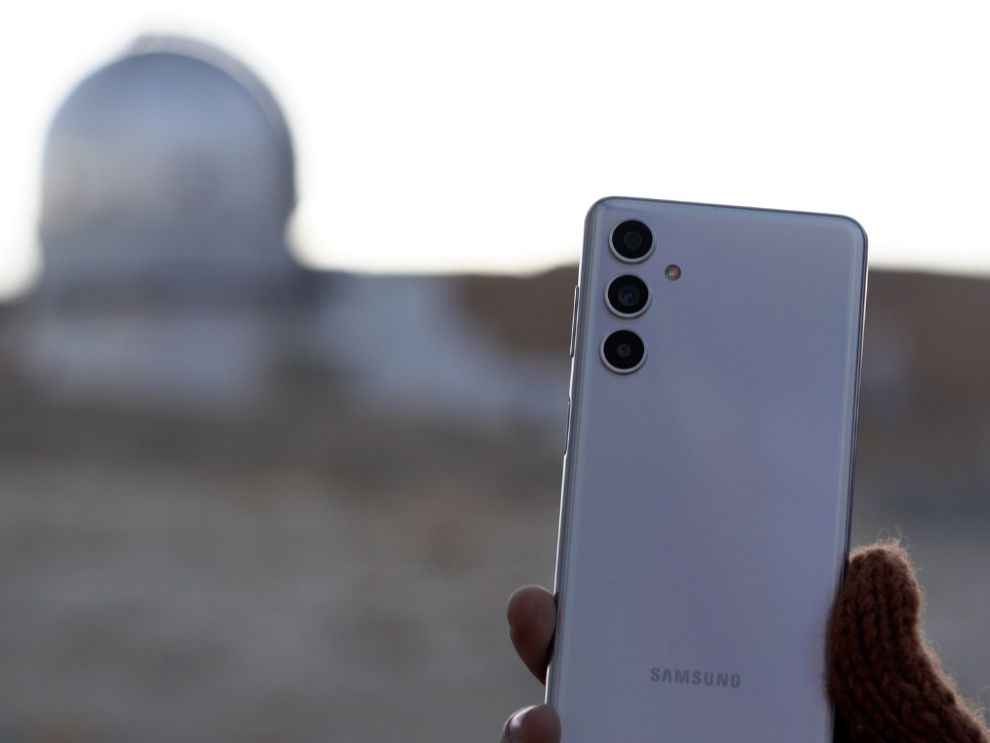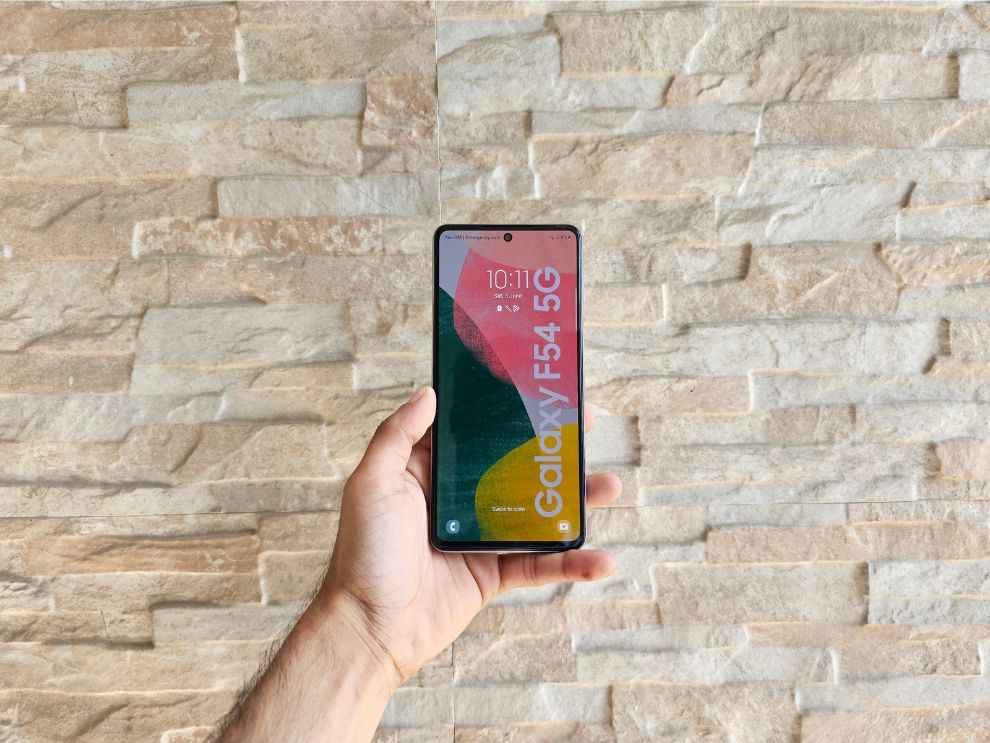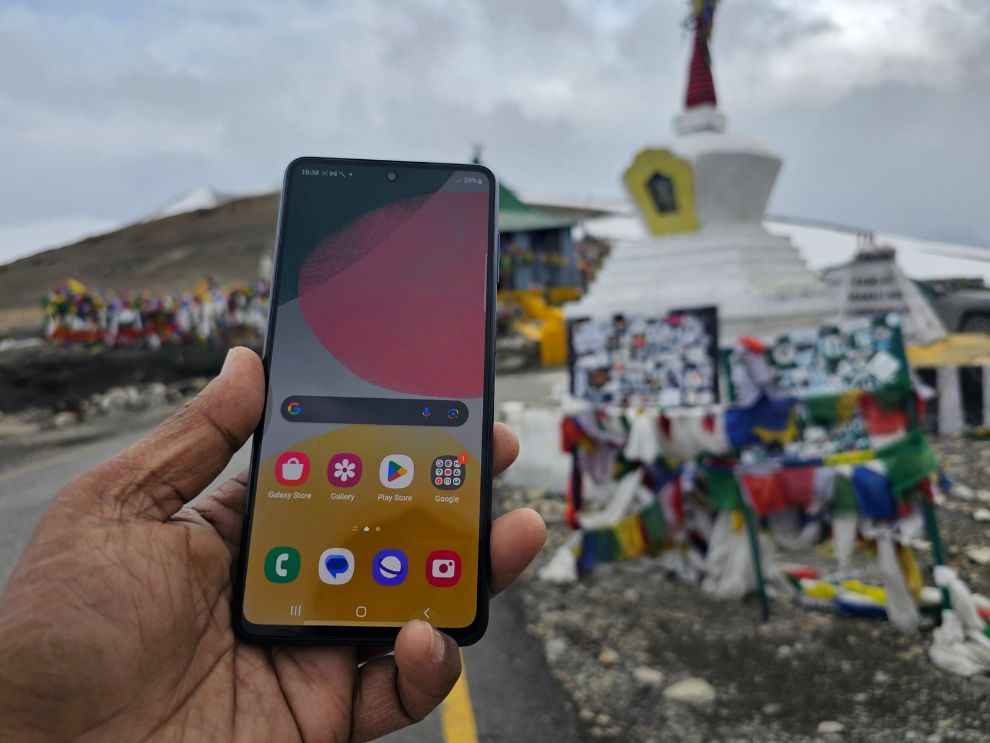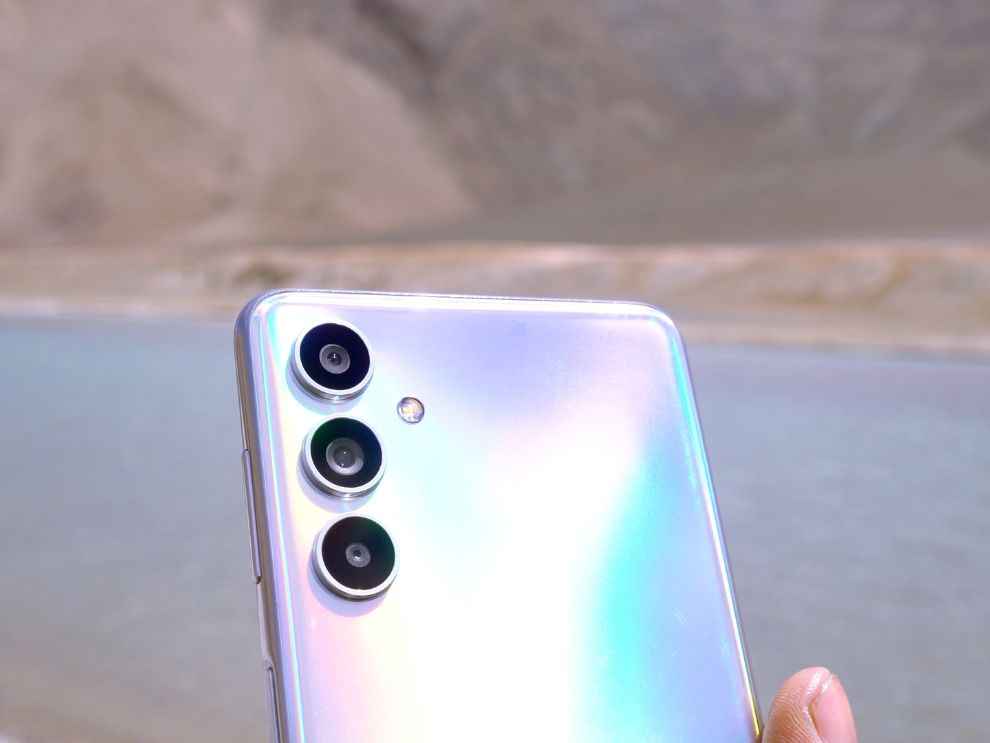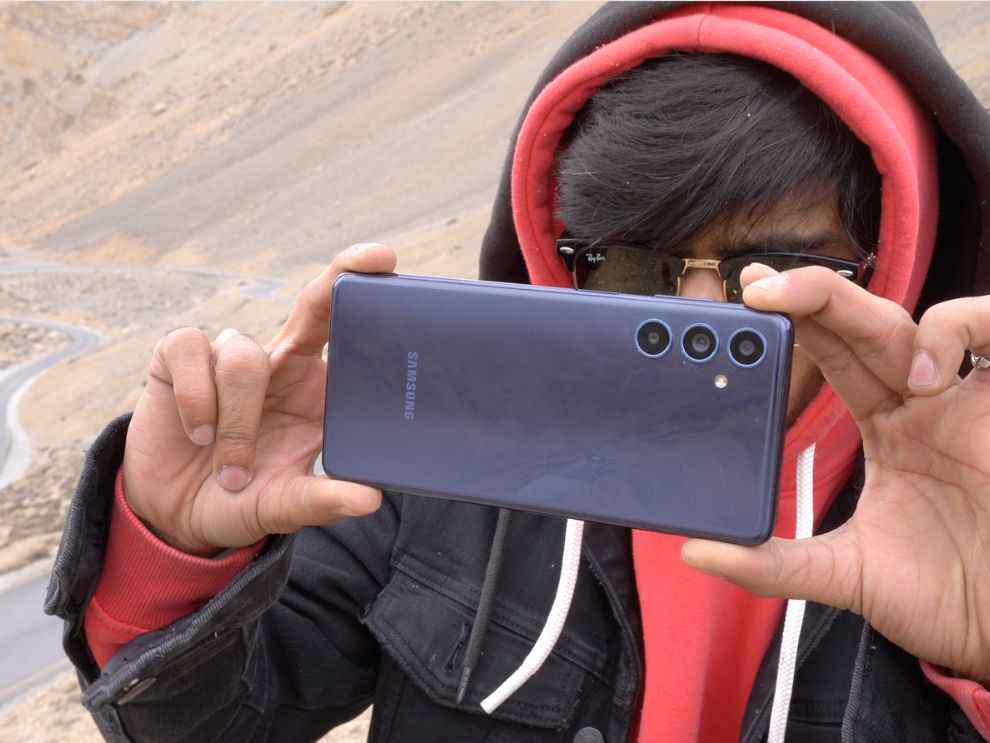Realme has delivered a truly elevated experience with the Realme 11 Pro in terms of design language, camera quality, display, and even battery life. When compared to the Realme 10 Pro, the improvements are tangible. Of course, that being said, the Realme 11 Pro+ is quite close in price but offers some serious upgrades compared to the 11 Pro, so the company could be competing with itself in that regard. Nevertheless, in the sub-₹25K price segment, this is the best-looking phone, in my opinion, that also offers reliable performance in most other avenues.
Realme has a wide portfolio of value-for-money smartphones in India. The company's number series, Narzo series, and C series are ludicrously popular in our country given the features on offer at very competitive prices. Recently, Realme launched its latest number series phones in India – the Realme 11 Pro and Realme 11 Pro+ (review). At my briefing meeting with the company, I was told that both the Realme 11 Pro and Pro+ improve upon last year’s Realme 10 Pro+, so there are some massive upgrades on the vanilla 11 Pro version, and they’re not wrong in claiming that. So, naturally, when the Realme 11 Pro showed up at the Digit Test Labs, I was cautiously excited to review it and experience the upgrades. Compared to its predecessor, the Realme 10 Pro (review), the Realme 11 Pro sports an upgraded leather-back design, an improved AMOLED display, a faster processor, higher RAM, faster charging, and a new camera. That’s a lot of improvements on paper; but how does the Realme 11 Pro actually perform in real life and how much has it improved compared to its predecessor? Does it match up to the competition at ₹23,999? I answer these questions and more in my detailed review of the Realme 11 Pro.
Realme 11 Pro Review: Build and designWhen you set your eyes on the Realme 11 Pro, one of the more obvious improvements is the design. Gone is the cheap-looking plastic rear panel and now we’ve got a sophisticated vegan leather finish on the back of the Oasis Green and Sunrise Beige colour variants. We got the latter for review, and it exudes class that’s quite rare to see at this price point. The look has been co-developed with ex-Gucci designer, Matteo Menotto. There’s also an Astral Black variant that comes with a simple matte-textured back; but simply because of how classy the leather variants look, we’d suggest that you stray away from the black variant.
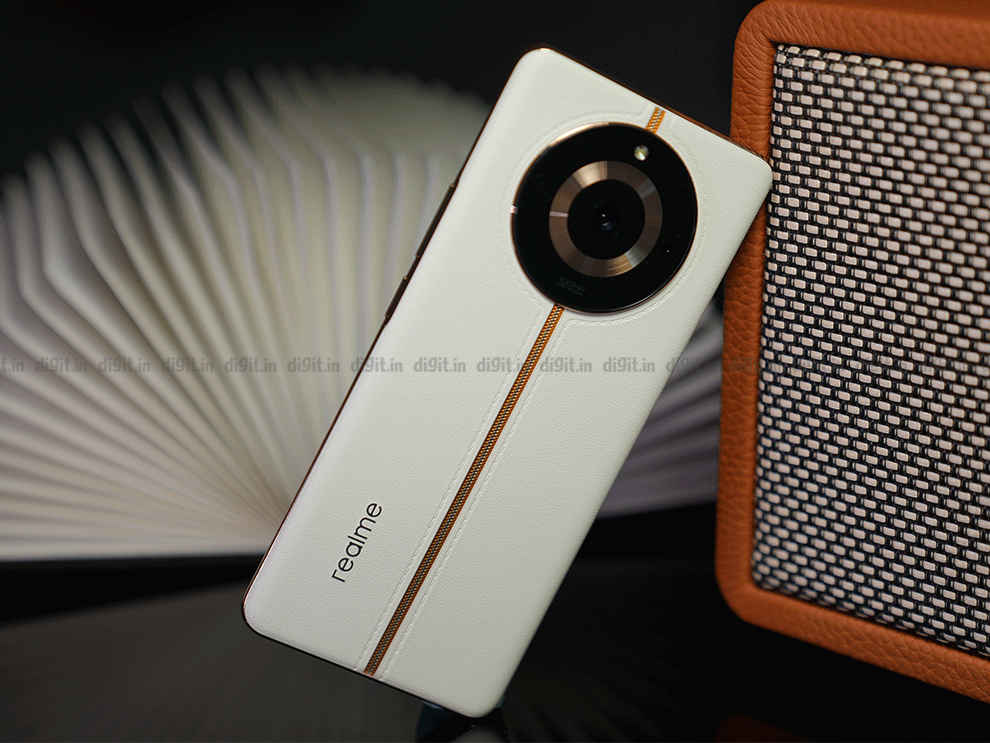
The phone also features an eye-catching circular camera module which houses the two camera lenses and a third pseudo-lens design – for symmetry reasons, I guess? There’s also a flash on top and “100 MP OIS Camera” written on the bottom. A golden zip-like pattern cuts through this module. This design flair can be a bit polarising, but I personally loved it; I thought it gave the phone a certain character. One thing missing is any kind of Ingress Protection – so the phone is neither dust nor water-resistant, which is disappointing but not a deal-breaker for most.
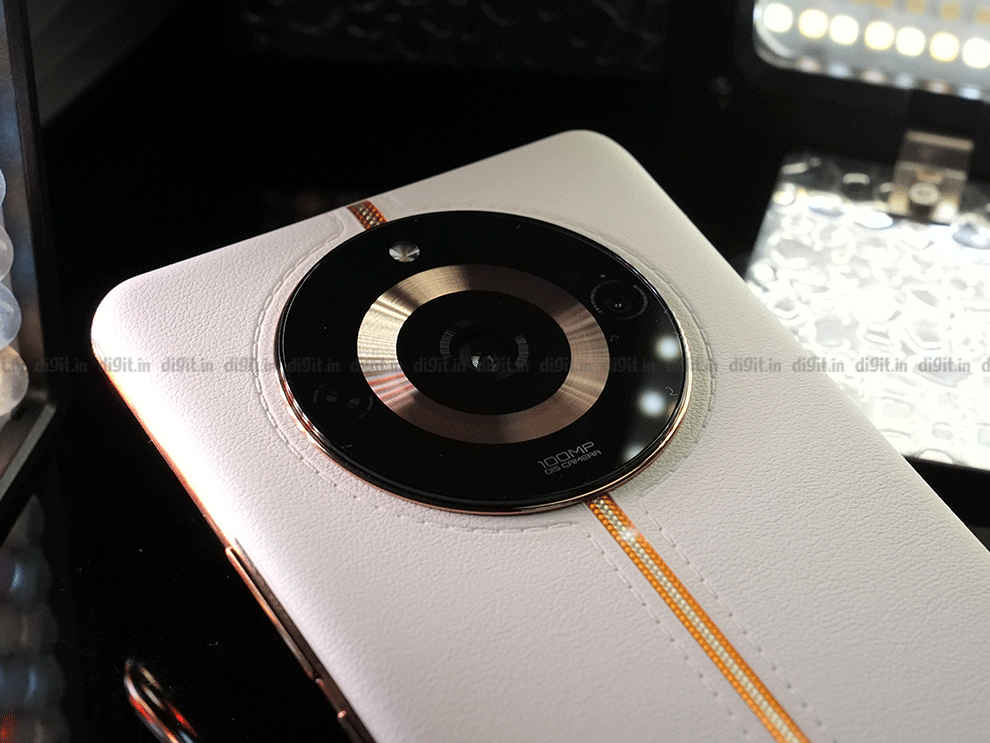
The Realme 11 Pro has nice and rounded corners both on the front and the back which makes the phone ridiculously comfortable to hold, however, the curved display does register some mistaps. The phone is lightweight too, at just 189 g (leather variant). The frame of my Sunrise Beige variant is a striking gold colour, which once again, makes the phone look much more expensive than it is. All that being said, the Realme 11 Pro is possibly one of the most stylish phones ₹25K with oodles of character. A head-turner for sure!

Now that you have a fair idea about the looks of the display, let’s get into the nitty-gritty. The Realme 11 Pro packs a 6.7-inch AMOLED screen with up to 120 Hz refresh rate and 360 Hz touch sampling rate. Do note that the Realme 10 Pro only had an IPS LCD display, so it's a tangible improvement. The display is topped with AGC DragonTrail Star glass for protection. Realme also promises a 1,260 Hz Instantaneous touch sampling rate – and boy, did we feel it during gaming. Touches were registered almost instantaneously with little to no lag or delay, making it a smooth experience at under ₹25K. There’s an optical in-display fingerprint sensor that worked a bit slower than ideal, during my testing.

The display has an FHD+ resolution which is plenty crisp for the price point. Colours look vibrant and there’s unmistakable detail in every frame. The display also supports 1 billion+ colours which should help avoid colour banding and it is a definite improvement over the Realme 10 Pro. You've got evenly thin bezels all the way around the AMOLED panel as well.
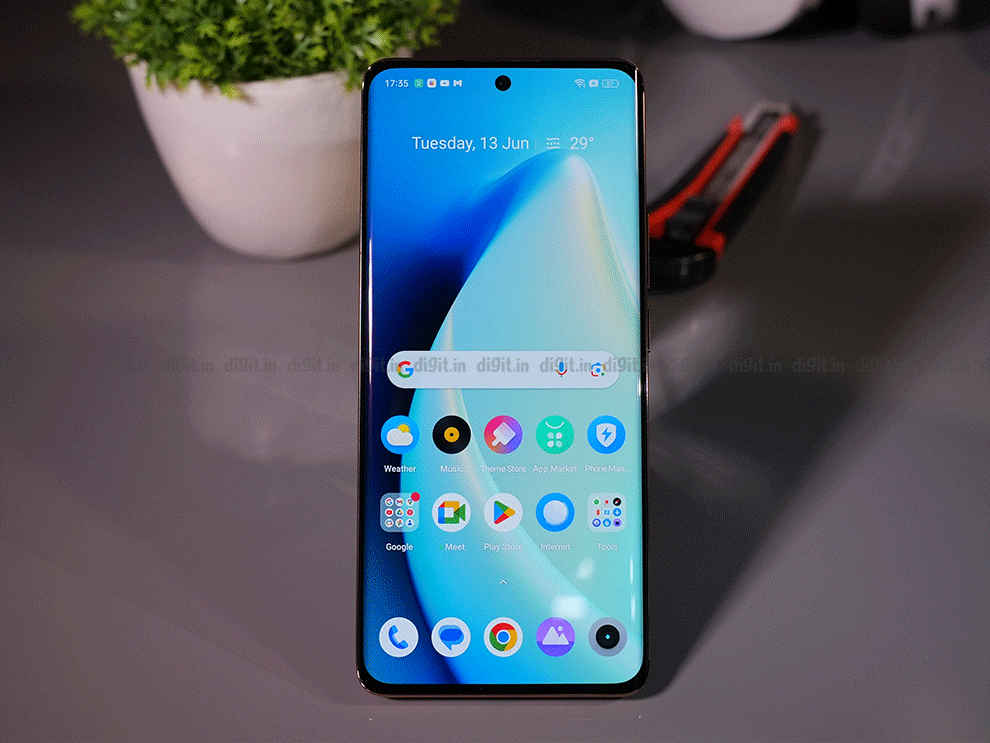
As for brightness, there’s little to complain about. Realme promises 950 nits of peak brightness and in my testing, I got a reading of 916 nits under direct sunlight on Auto-Brightness Mode. Pretty sweet. The AMOLED display can also get pretty dim, so the screen won’t bother you even when you’re using it at night with the lights turned off.
Realme has added HDR10+ support, but Dolby Vision support is missing. While it is good to have HDR10+ support, streaming services such as Netflix still don’t support HDR on the Realme 11 Pro. It could take a few updates to support to finally land, but this is something that should ideally be done pre-launch.
Realme 11 Pro Review: PerformanceAt under ₹25,000, the Realme 11 Pro performs decently well; but this performance is colossally hindered by bloatware. I have never experienced these levels of hardcore bloatware pushing. OPPO and OnePlus devices have similar numbers of pre-installed apps, but it is not as intense.
Let me explain: not only does the phone come pre-installed with a bunch of third-party apps, but you also have about 8-10 games being auto-installed during set-up despite never explicitly giving permission. Add to that excessive pop-up notifications, folders of “suggested apps” that cannot be removed and more, and you’ve got yourself an unpleasant UI experience.
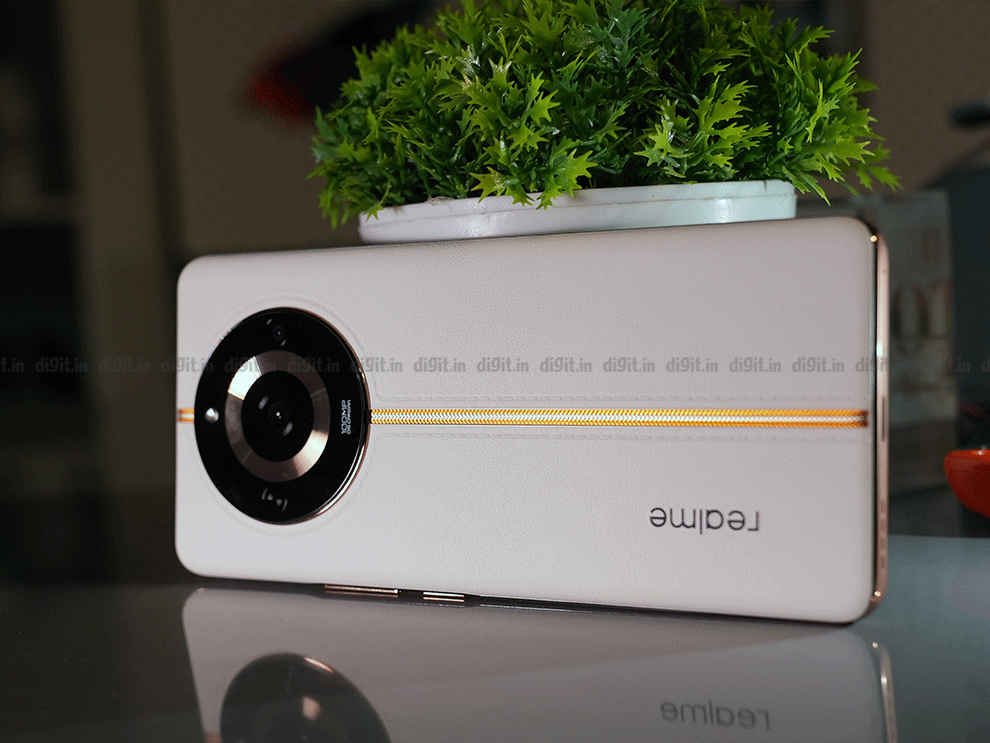
The phone comes with Android 13 with Realme UI 4.0 on top. The company promises 2 years of OS updates and 3 years of security updates as well, which is pretty decent. Software and UI aside, let’s now delve into the hardware of the phone that makes the phone tick.
The Realme 11 Pro is powered by the MediaTek Dimensity 7050 SoC which is manufactured on the 6 nm process and comes with a maximum clock speed of 2.6 GHz. At this price range, the processor performs admirably well, beating out a couple of similarly-priced alternatives. I compared the Realme 11 Pro to the OPPO F23 5G, POCO X5 Pro, and last year’s Redmi K50i.
The Realme 11 Pro beat out the OPPO F23 and POCO X5 Pro in both AnTuTu and GeekBench Single Core. However, in the Multi-Core test, the POCO X5 Pro pulls ahead. The Redmi K50i beats the Realme 11 Pro soundly in AnTuTu and GeekBench Multi-Core but lags behind slightly in the Single Core test. One area where the Realme 11 Pro shone was PCMarkWork which emulates day-to-day tasks such as using sheets, photo editing, and more. The Realme 11 Pro beat out all three competitors with ease here.
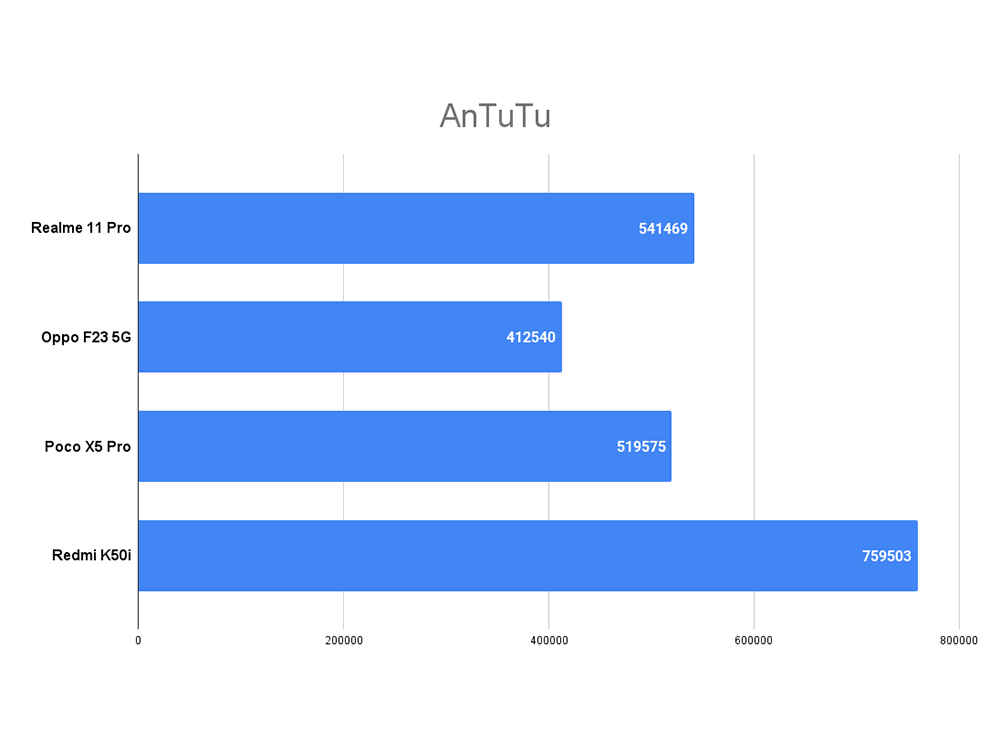
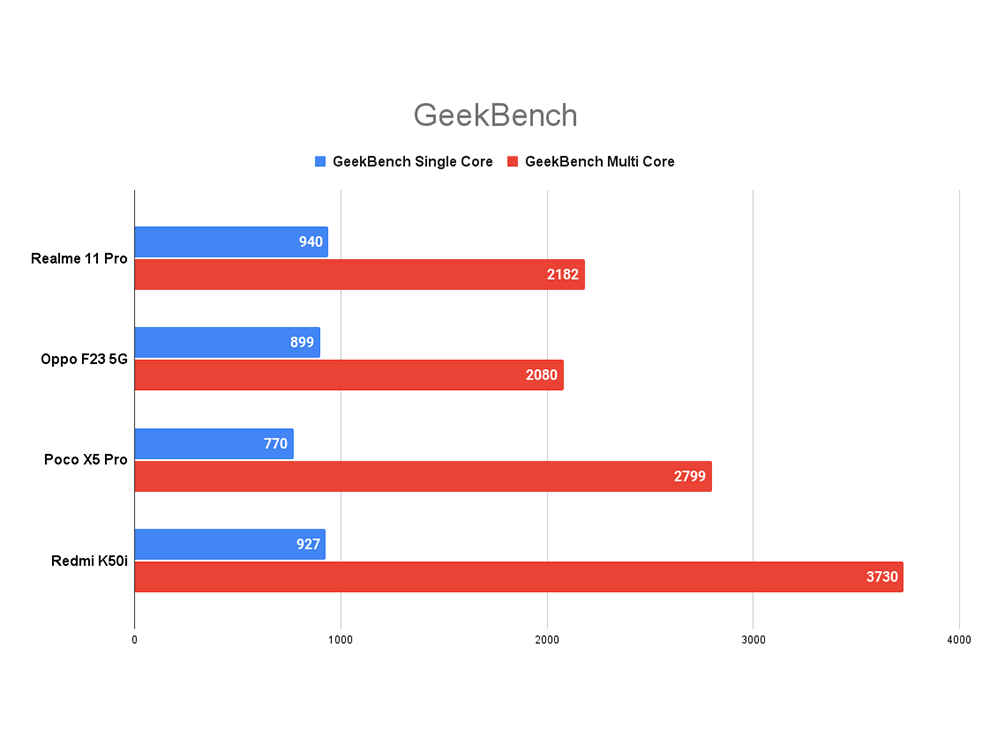
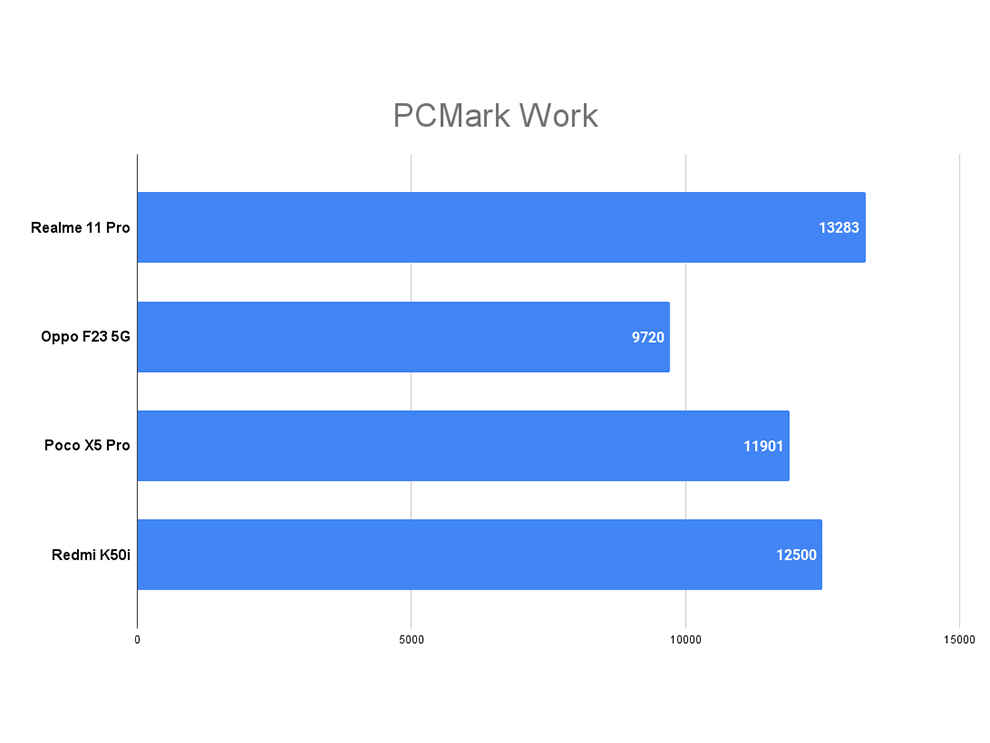
In GPU tests though, the Realme 11 Pro falls behind with the POCO X5 Pro and Redmi K50i clocking better scores in GFXBench and 3D Mark. Real-world gaming was smooth though. I was getting consistent frame rates at High Graphics with ease and the phone also didn’t heat up much during extended gaming sessions. We tried Asphalt 9 Legends on this phone as well, and the experience was excellent.

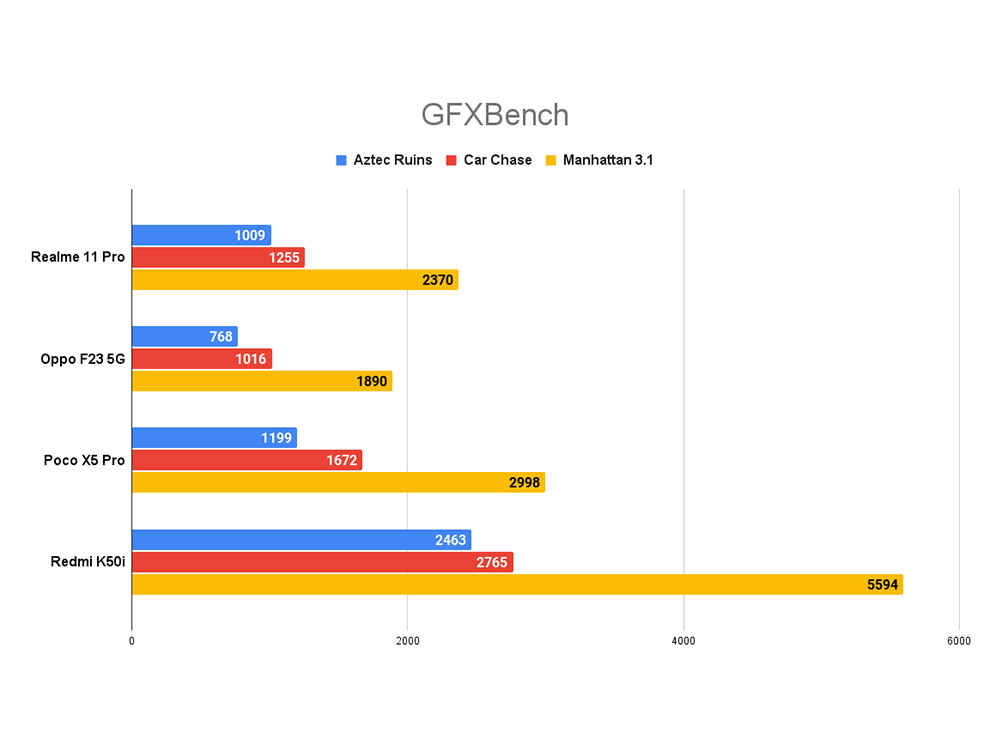
Realme has done well controlling the thermals of the phone, so the phone barely throttles even at peak load. In the CPU Throttling Test, the Realme 11 Pro throttled to 92 per cent of its peak performance, which is excellent. Overall, the phone offers smooth and reliable performance in the sub-₹25K price segment; it is nothing game-changing but it is decent. However, this experience is marred by excessive bloatware and push notifications.
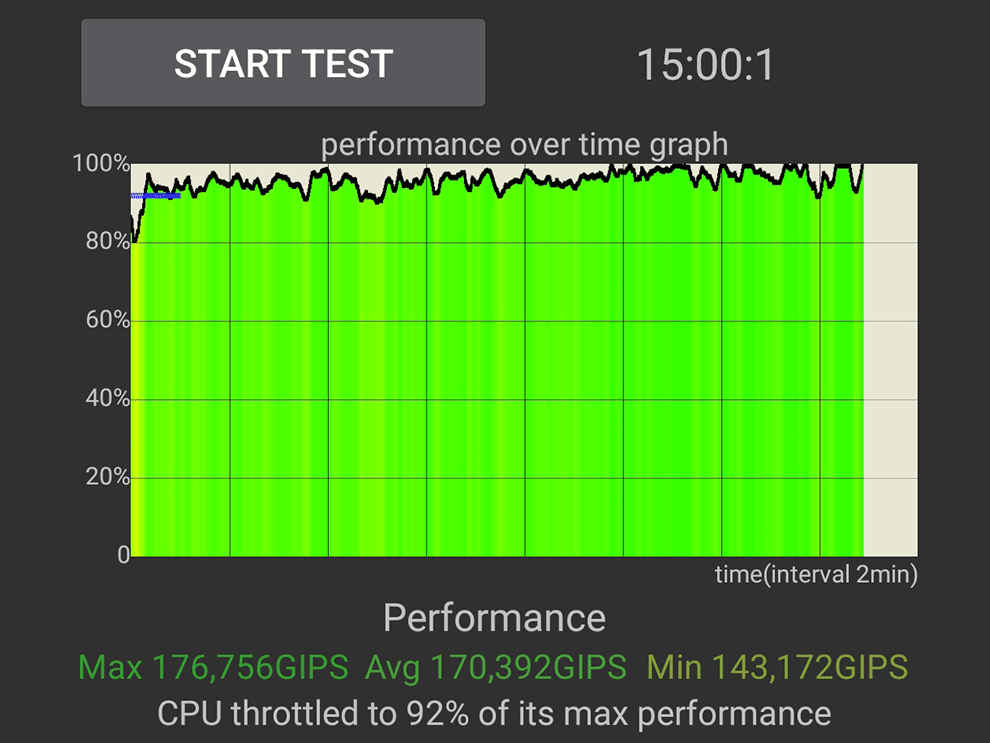
Realme has packed new cameras in its latest number series. While the Realme 11 Pro+ gets a 200 MP shooter, the 11 Pro houses a 100 MP Omnivision camera alongside a token 2 MP depth lens. The primary camera has Optical Image Stabilisation support as well. Realme also heavily promoted its 2x lossless or “in-sensor zoom” heavily. There's also an Auto Zoom feature that crops onto a subject and attempts to centre it in the frame.
\
The selfie camera is a 16 MP Sony IMX471 lens which we've seen on some Realme phones before. The 100 MP camera saves 12 MP shots by default and the photos taken in daylight look fantastic, for the most part. The dynamic range is solid, detail retention is good, and colours are vivid - a bit oversaturated, but many may enjoy this look. Here are some photo samples. Do note, these have been compressed for the web:


The 2x lossless zoom shots are packed with detail but they do look a bit oversharpened. There's also an option to click full resolution 100 MP shots that have natural colours but slightly inadequate dynamic range.
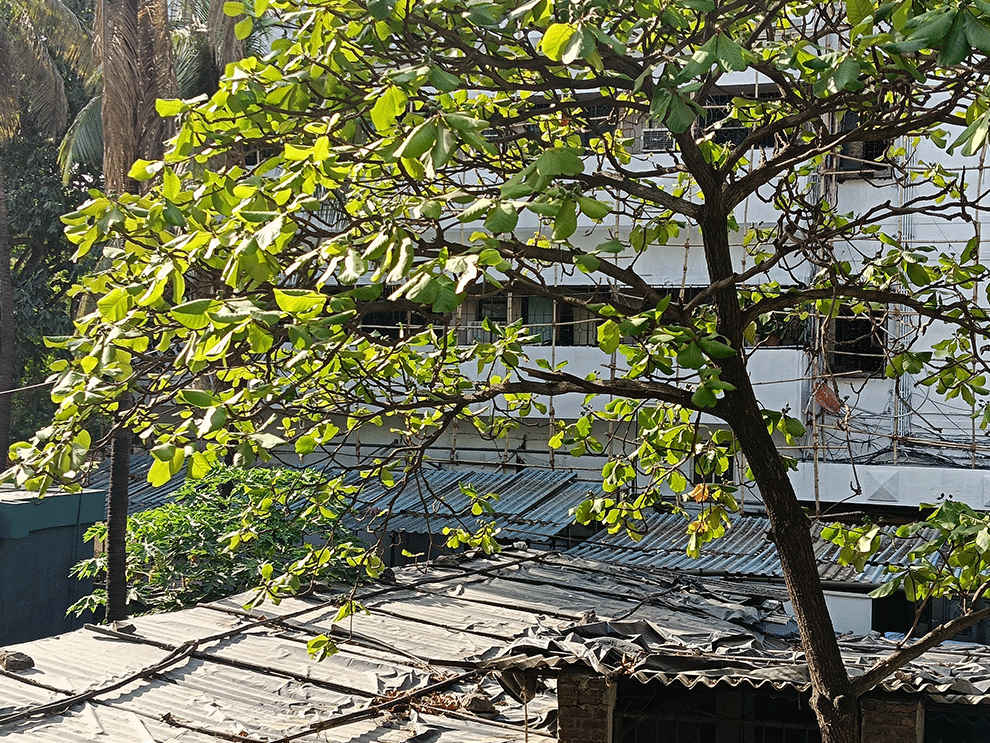
2x lossless zoom photo sample
Portrait images that are assisted by the 2 MP depth lens look good with decent edge detection, however, skin tones aren't the most accurate. Selfie photos from the 16 MP shooter look slightly soft and struggle with dynamic range in tricky lighting.

Low light shots from the 100 MP camera are quite impressive; colours look good, dynamic range is decent and the detail is also adequate. There is some noise but I've seen worse at this price. Turning on Nightscape alleviates some noise issues, but the photos can look slightly unnatural.
Realme 11 Pro Review: Battery lifeThe Realme 11 Pro features a 5,000 mAh battery, the same as its predecessor. The phone comes equipped with 67 W fast charging, a marked improvement over the 10 Pro. There’s no wireless charging, but that’s a rarity in the mid-range smartphone segment.
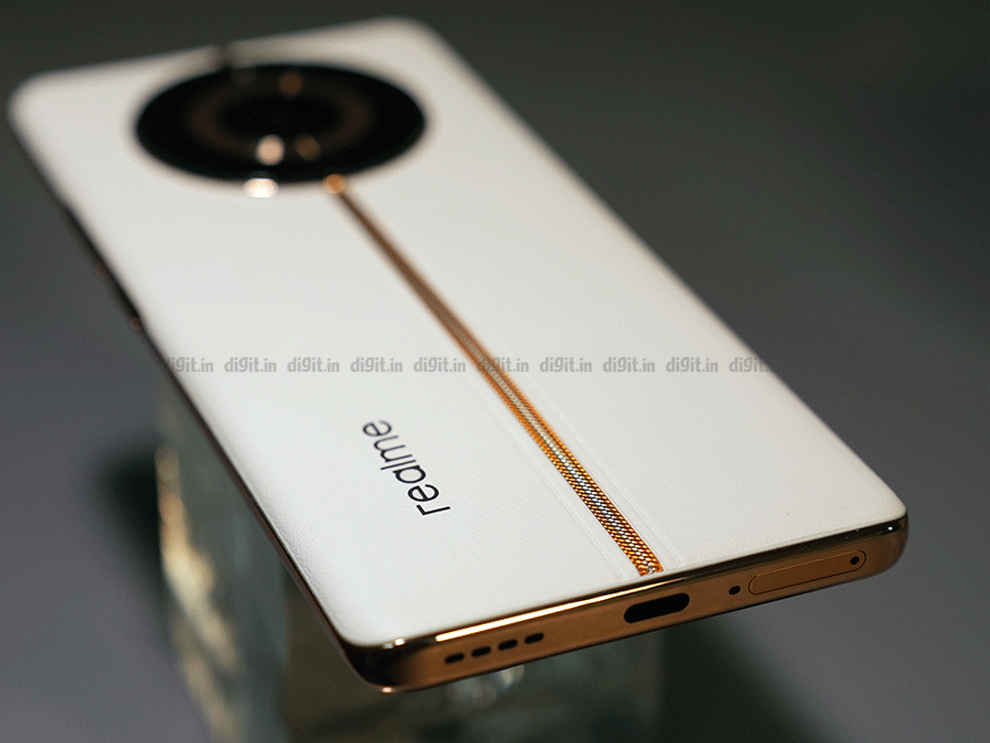
The phone's battery life is impressive and long-lasting; the device lasted 14 hours and 15 minutes in our 4K video loop test on a full charge. I played Call of Duty: Mobile for 15 minutes, and the phone’s battery level only dropped by 4 per cent (from 88% to 84%) and GPS Navigation for an hour on Google Maps dropped it by 5 per cent (83 % to 78%). A full charge using the bundled 67 W charger took 46 minutes, and charging the phone up to 50 per cent merely took 18 minutes.
Realme 11 Pro Review: VerdictRealme has delivered a truly elevated experience with the Realme 11 Pro in terms of design language, camera quality, display, and even battery life. When compared to the Realme 10 Pro, the improvements are tangible. Of course, that being said, the Realme 11 Pro+ is quite close in price but offers some serious upgrades compared to the 11 Pro, so the company could be competing with itself in that regard. Nevertheless, in the sub-₹25K price segment, this is the best-looking phone, in my opinion, that also offers reliable performance in most other avenues. Low-light photography could be slightly improved and an IP rating would be an added assurance. But we are nitpicking, and these misses wouldn’t necessarily affect too many people’s buying decisions. For the price, the Realme 11 Pro is an easy recommendation; a well-rounded phone. However, if you are an ardent mobile gamer who only cares about performance, the Redmi K50i (review) and the more expensive iQOO Neo 7 (review) are better options.
from Mobile Phones Reviews https://ift.tt/RzLnsJM
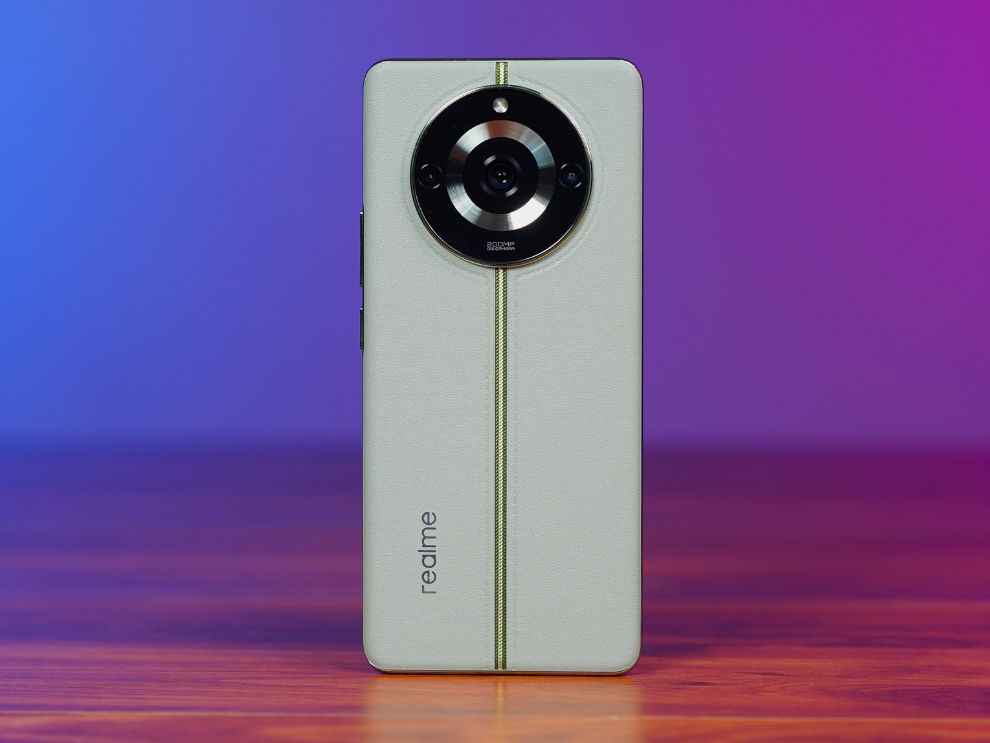 Now, I have been using the Realme 11 Pro+ for the last couple of weeks, and the smartphone has impressed me quite a bit, especially in the design, display, and camera department. There are some shortcomings with the Realme 11 Pro+ as well, including the software, the performance, and more, but we will get to that later. First, let us take a look at what has improved as compared to the previous generation. Realme 11 Pro+ 5G Review: Design The design of the Realme 11 Pro+ is probably my favourite thing about this device. The smartphone has been designed in collaboration with former Gucci and current Bulgari designer Matteo Menotto and the results have paid off! The Realme 11 Pro+ comes with a nice curved display design, with a very beautiful back panel made with vegan leather. We get a huge circular camera module that holds the triple rear camera, and there is a leather back panel, which is divided into two by a fabric stitched strip that runs down the middle of the camera module.
Now, I have been using the Realme 11 Pro+ for the last couple of weeks, and the smartphone has impressed me quite a bit, especially in the design, display, and camera department. There are some shortcomings with the Realme 11 Pro+ as well, including the software, the performance, and more, but we will get to that later. First, let us take a look at what has improved as compared to the previous generation. Realme 11 Pro+ 5G Review: Design The design of the Realme 11 Pro+ is probably my favourite thing about this device. The smartphone has been designed in collaboration with former Gucci and current Bulgari designer Matteo Menotto and the results have paid off! The Realme 11 Pro+ comes with a nice curved display design, with a very beautiful back panel made with vegan leather. We get a huge circular camera module that holds the triple rear camera, and there is a leather back panel, which is divided into two by a fabric stitched strip that runs down the middle of the camera module. 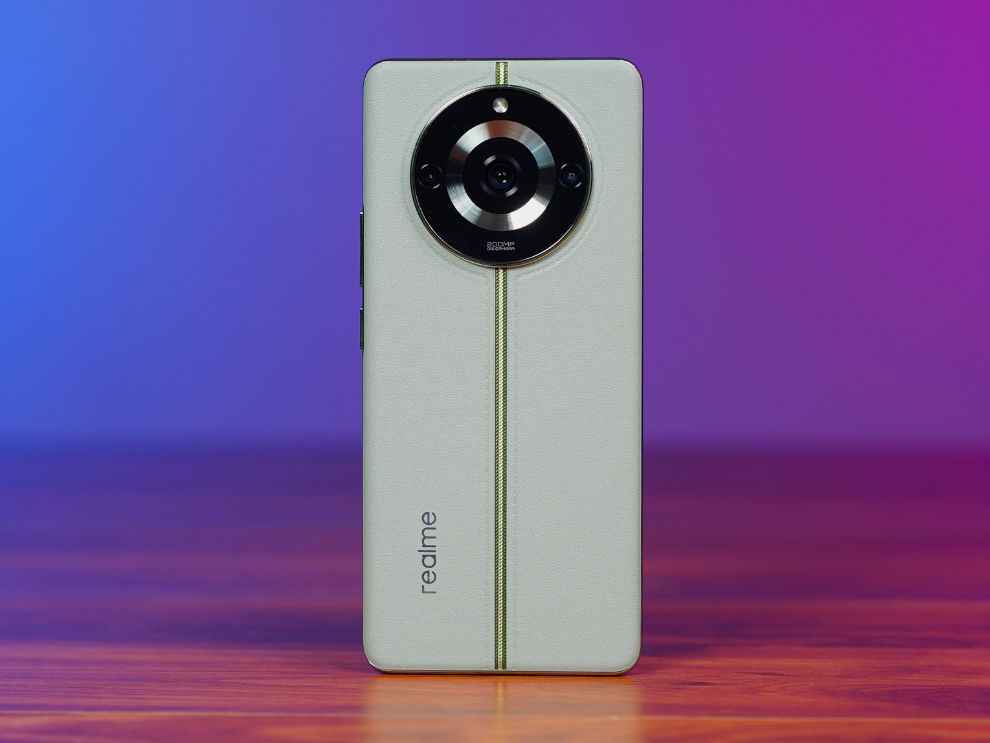 The back panel looks quite stunning, in my opinion. The leather feel of the curved back panel with the stitching patterns looks really premium and gives a very luxurious in-hand feel. The size is also pretty decent. the Realme 11 Pro+ isn’t very big and single-handed usage is also pretty easy and convenient. While it has a fairly large 6.7-inch display, the end-to-end screen with the curved implementation keeps the size in check quite nicely. The Realme 11 Pro+ is also quite lightweight, weighing just 189 grams. Good.
The back panel looks quite stunning, in my opinion. The leather feel of the curved back panel with the stitching patterns looks really premium and gives a very luxurious in-hand feel. The size is also pretty decent. the Realme 11 Pro+ isn’t very big and single-handed usage is also pretty easy and convenient. While it has a fairly large 6.7-inch display, the end-to-end screen with the curved implementation keeps the size in check quite nicely. The Realme 11 Pro+ is also quite lightweight, weighing just 189 grams. Good. 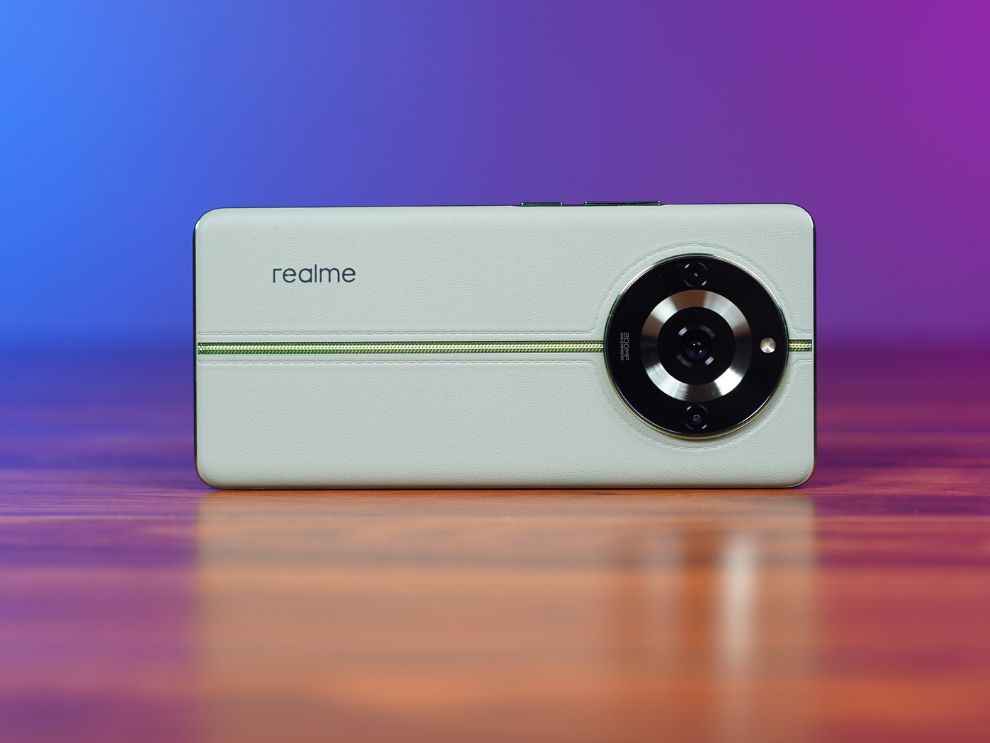 Up front also, we get a very premium-looking curved display which nicely blends into the frame of the smartphone. Complemented with the back panel also flowing nicely into the frame, even the smartphone’s side profile is very good-looking. Overall, I think Realme has got things right this time around, at least in the design department. Realme has also been the brand that experiments a lot with its designs. At times, these designs don’t really pay off, but with the Realme 11 Pro series, the brand has probably made the best-looking smartphone in this segment.
Up front also, we get a very premium-looking curved display which nicely blends into the frame of the smartphone. Complemented with the back panel also flowing nicely into the frame, even the smartphone’s side profile is very good-looking. Overall, I think Realme has got things right this time around, at least in the design department. Realme has also been the brand that experiments a lot with its designs. At times, these designs don’t really pay off, but with the Realme 11 Pro series, the brand has probably made the best-looking smartphone in this segment. 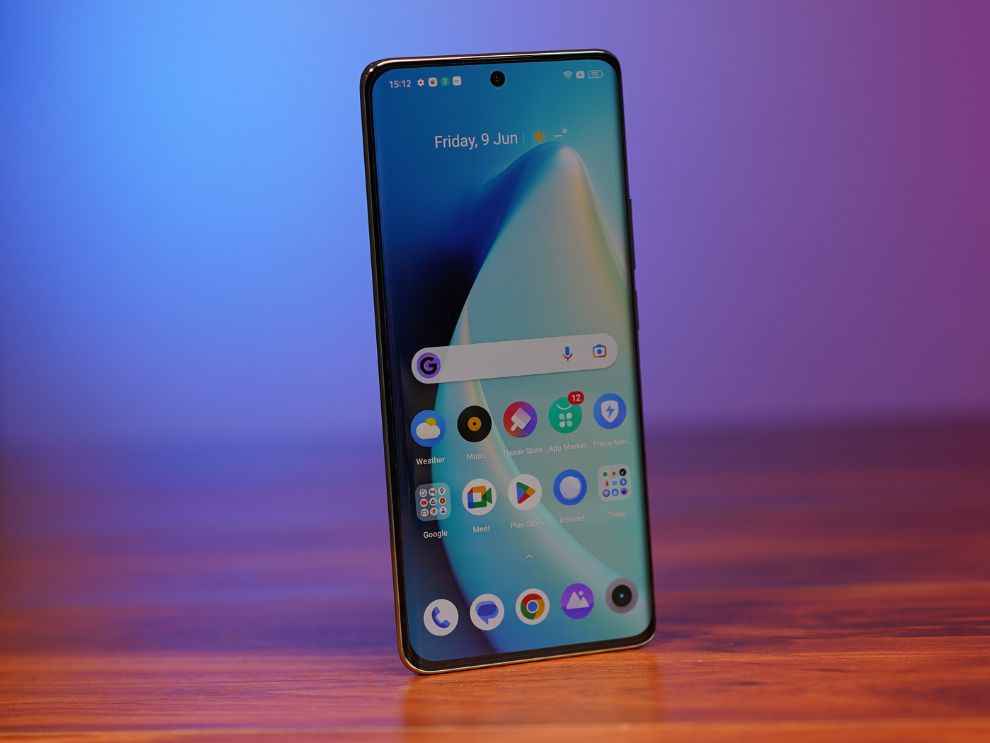 Realme 11 Pro+ Review: Display Coming to the display, this is another one of my favourite things about the smartphone. The Realme 11 Pro+ display is a nice 6.7-inch curved AMOLED panel with an FHD+ resolution and 120Hz refresh rate. The 10-bit display on the Realme 11 Pro+ also supports HDR10+, which makes watching content on this device a very good experience. Further, the display has a brightness of 823 nits. We put this to the test using a Lux Meter, and the smartphone showed a pretty decent max luminance of 823 nits, with the minimum luminance being 3 nits on a plain white screen. This is a very good range. Of course, this is an AMOLED display, so the brightness is good and it feels more vibrant, given the sharper details and a wider range of colours. I also put the Realme 11 Pro+ through the Calman test, and the smartphone showed very good colour accuracy. In sRGB Colour Match, the Realme 11 Pro+ showed an astonishing average DeltaE of 1.6 in sRGB colour checker analysis. This is one of the best numbers we have ever seen in the sRGB colour checker analysis in this segment. In fact, the Realme 11 Pro+ showed a maximum DeltaE of 3.8, which is pretty decent for being an average DeltaE for this kind of device, let alone be the maximum-possible error in terms of accuracy. The colour checker analysis showed that Realme 11 Pro+'s display mostly misses out in shades of orange or brown, or even red slightly.
Realme 11 Pro+ Review: Display Coming to the display, this is another one of my favourite things about the smartphone. The Realme 11 Pro+ display is a nice 6.7-inch curved AMOLED panel with an FHD+ resolution and 120Hz refresh rate. The 10-bit display on the Realme 11 Pro+ also supports HDR10+, which makes watching content on this device a very good experience. Further, the display has a brightness of 823 nits. We put this to the test using a Lux Meter, and the smartphone showed a pretty decent max luminance of 823 nits, with the minimum luminance being 3 nits on a plain white screen. This is a very good range. Of course, this is an AMOLED display, so the brightness is good and it feels more vibrant, given the sharper details and a wider range of colours. I also put the Realme 11 Pro+ through the Calman test, and the smartphone showed very good colour accuracy. In sRGB Colour Match, the Realme 11 Pro+ showed an astonishing average DeltaE of 1.6 in sRGB colour checker analysis. This is one of the best numbers we have ever seen in the sRGB colour checker analysis in this segment. In fact, the Realme 11 Pro+ showed a maximum DeltaE of 3.8, which is pretty decent for being an average DeltaE for this kind of device, let alone be the maximum-possible error in terms of accuracy. The colour checker analysis showed that Realme 11 Pro+'s display mostly misses out in shades of orange or brown, or even red slightly. 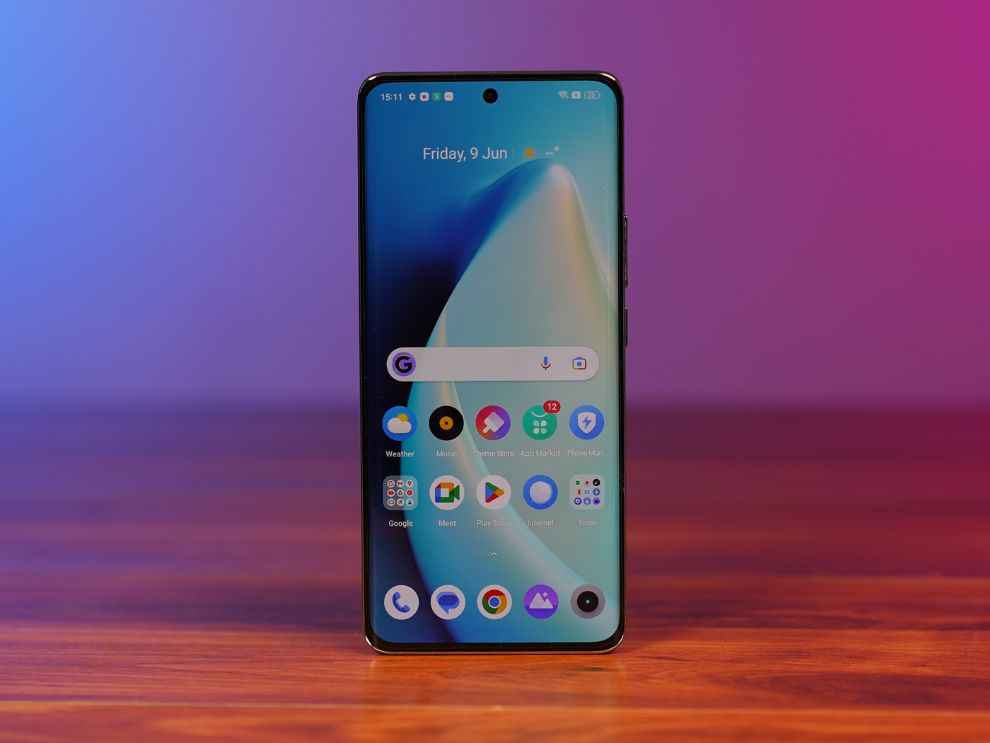
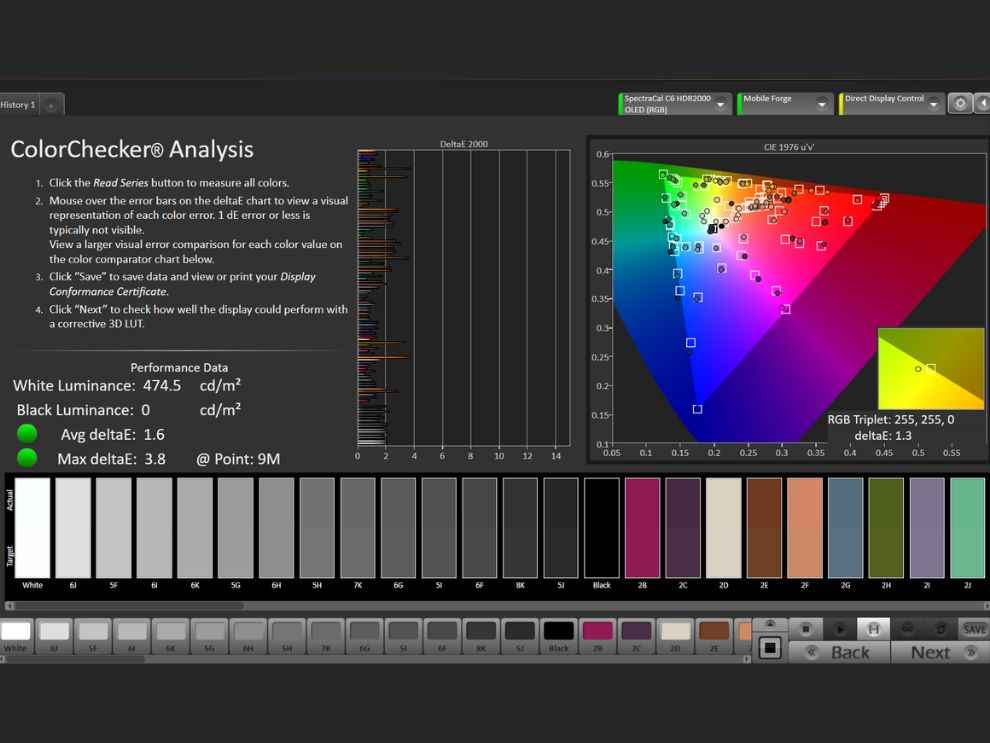 The results were equally good in the DCI-P3 colour checker analysis. Here, the Realme 11 Pro+ showed an average DeltaE of 2.2, which means that the colour accuracy on this display is very good.
The results were equally good in the DCI-P3 colour checker analysis. Here, the Realme 11 Pro+ showed an average DeltaE of 2.2, which means that the colour accuracy on this display is very good. 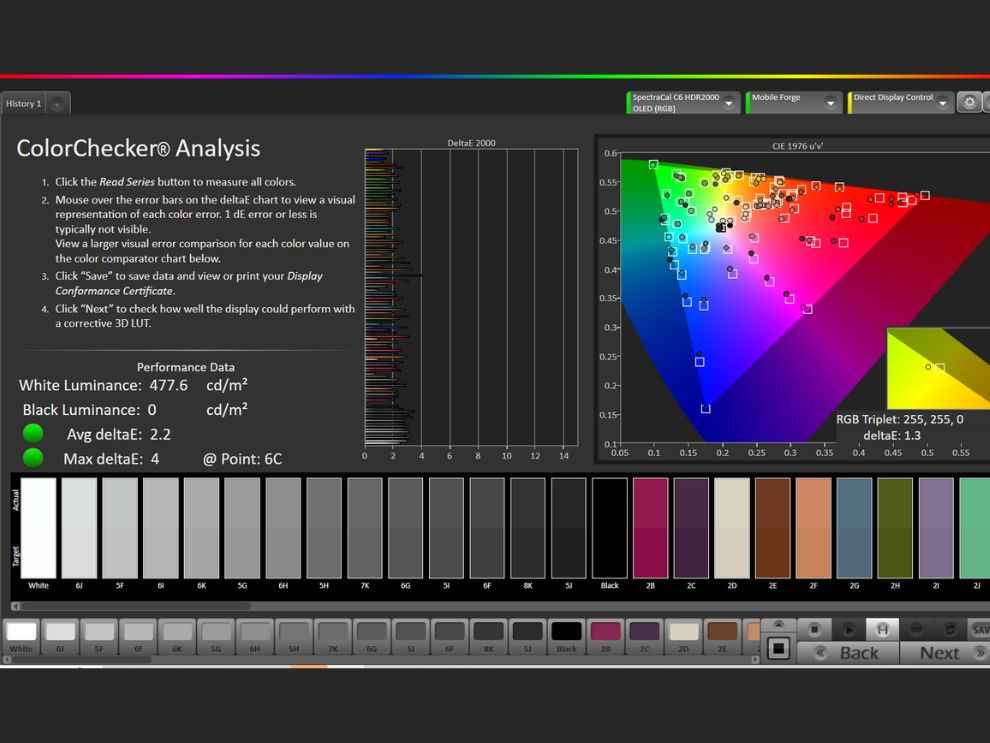 I also ran a Grayscale test on the Realme 11 Pro+. Here also, the Realme 11 Pro+ display showed a very good RGB balance. In both sRGB and DCI-P3 colour profiles, the green value was marginally higher than the blue and red, but apart from that, the results were pretty much perfect.
I also ran a Grayscale test on the Realme 11 Pro+. Here also, the Realme 11 Pro+ display showed a very good RGB balance. In both sRGB and DCI-P3 colour profiles, the green value was marginally higher than the blue and red, but apart from that, the results were pretty much perfect. 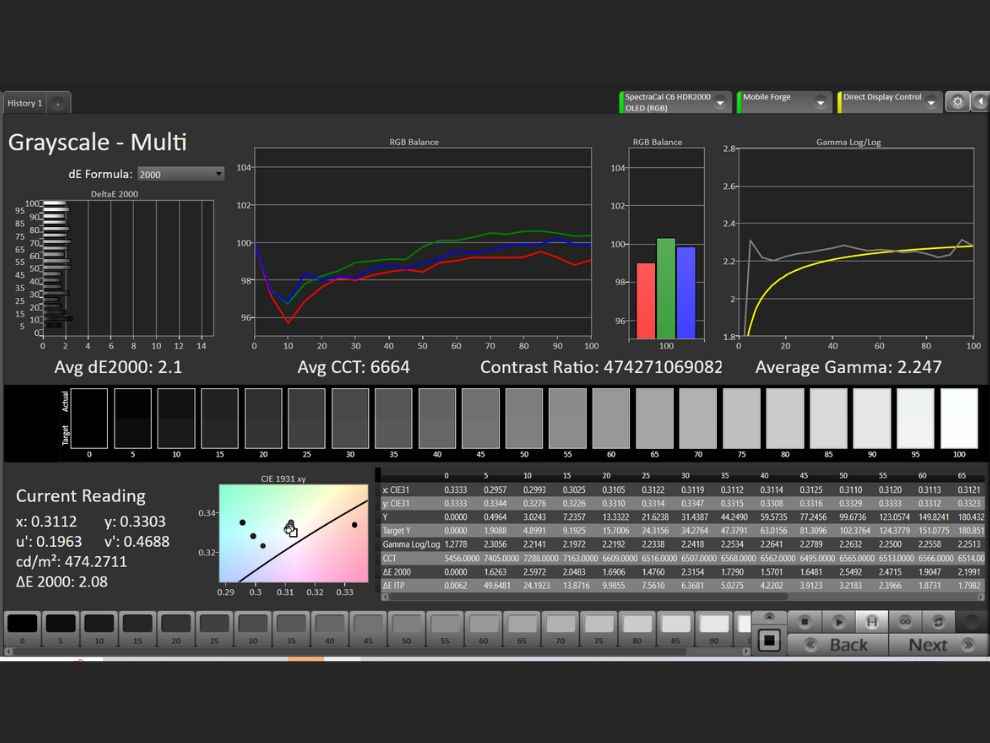 So overall, this is a pretty kickass display. From the colour accuracy to the responsiveness to even the brightness, this is pretty much one of the best displays in this segment.
So overall, this is a pretty kickass display. From the colour accuracy to the responsiveness to even the brightness, this is pretty much one of the best displays in this segment. 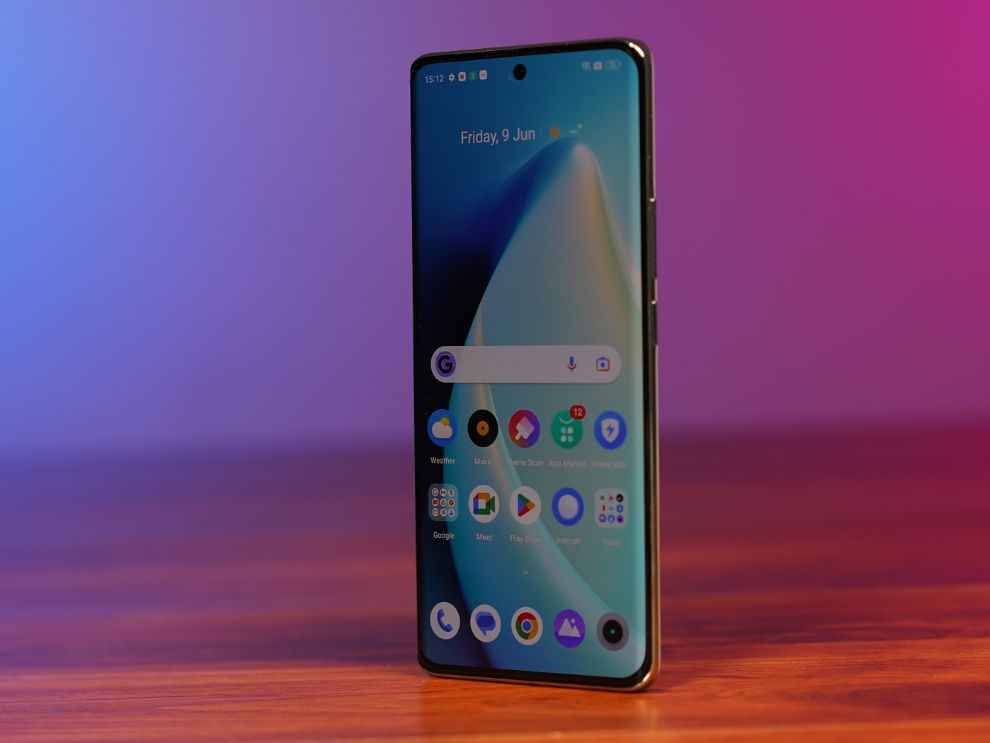 Realme 11 Pro+ 5G: Camera Coming to the main part, the camera. Now, the camera is the main focus of the Realme 11 Pro+ 5G. As a result, we get a lot of new features and hardware. On the hardware front, there is a triple rear camera setup that includes a primary 200-megapixel Samsung ISOCELL HP3 shooter, an 8-megapixel ultrawide angle lens, and a 2-megapixel macro shooter. For selfies, the Realme 11 Pro+ uses a 32-megapixel front camera.
Realme 11 Pro+ 5G: Camera Coming to the main part, the camera. Now, the camera is the main focus of the Realme 11 Pro+ 5G. As a result, we get a lot of new features and hardware. On the hardware front, there is a triple rear camera setup that includes a primary 200-megapixel Samsung ISOCELL HP3 shooter, an 8-megapixel ultrawide angle lens, and a 2-megapixel macro shooter. For selfies, the Realme 11 Pro+ uses a 32-megapixel front camera. 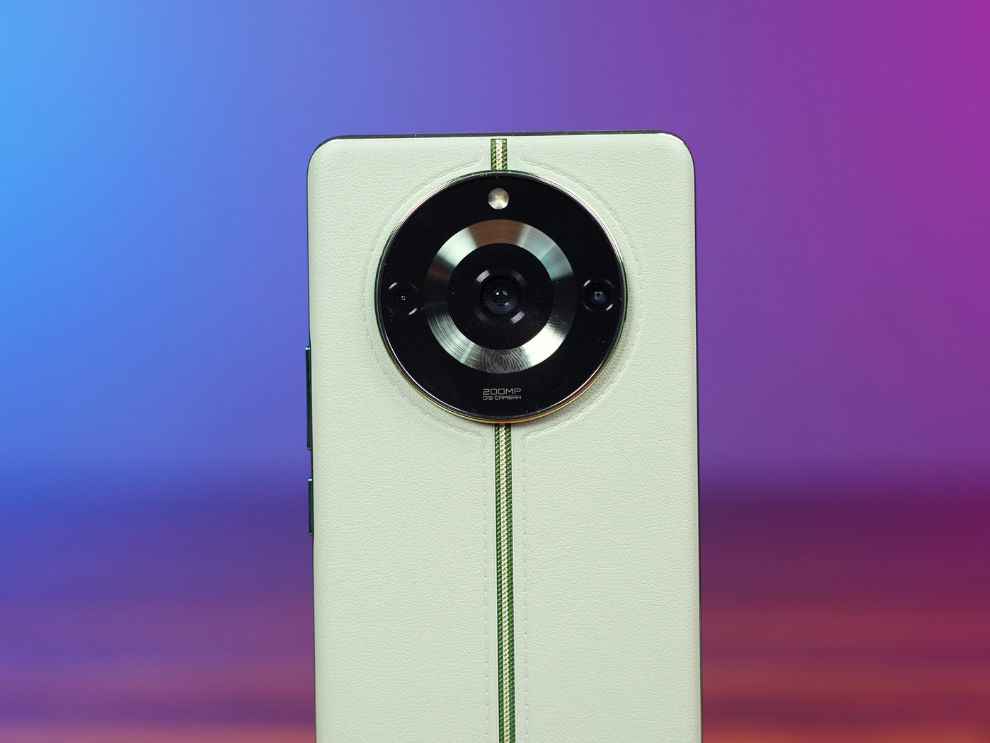 Now, talking about the smartphone’s camera performance, the Realme 11 Pro+ does fulfil its purpose. As we saw with the Realme 10 Pro+ back in December, the camera performance wasn’t on the same level as the smartphone’s predecessor, the Realme 9 Pro+. With the Realme 11 Pro+ 5G, the brand seems to have redeemed its position, in terms of offering a worthy camera setup.
Now, talking about the smartphone’s camera performance, the Realme 11 Pro+ does fulfil its purpose. As we saw with the Realme 10 Pro+ back in December, the camera performance wasn’t on the same level as the smartphone’s predecessor, the Realme 9 Pro+. With the Realme 11 Pro+ 5G, the brand seems to have redeemed its position, in terms of offering a worthy camera setup. 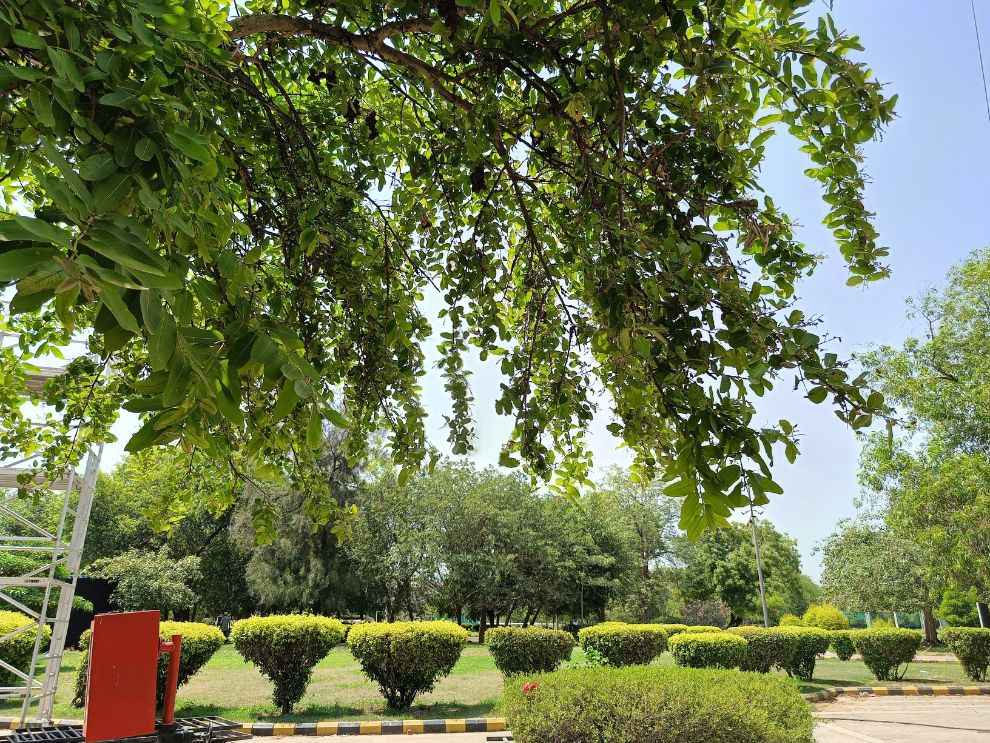
 The images from the primary shooter on the Realme 11 Pro+ are very good. The photos are detailed and the colour representation is also very close to accurate. By default, the smartphone uses 16x pixel binning to give us 12.5-megapixel images. While the images in normal mode are very good, in 200-megapixel I found the camera to be taking in way too much light in very bright environments, which results in blown-up colours and crushed details. For example, in the shot below, the smartphone wasn’t able to manage the abundance of light, resulting in the image appearing a bit too bright to even see the details (the above image is 200-megapixel, below is the default mode with pixel binning).
The images from the primary shooter on the Realme 11 Pro+ are very good. The photos are detailed and the colour representation is also very close to accurate. By default, the smartphone uses 16x pixel binning to give us 12.5-megapixel images. While the images in normal mode are very good, in 200-megapixel I found the camera to be taking in way too much light in very bright environments, which results in blown-up colours and crushed details. For example, in the shot below, the smartphone wasn’t able to manage the abundance of light, resulting in the image appearing a bit too bright to even see the details (the above image is 200-megapixel, below is the default mode with pixel binning). 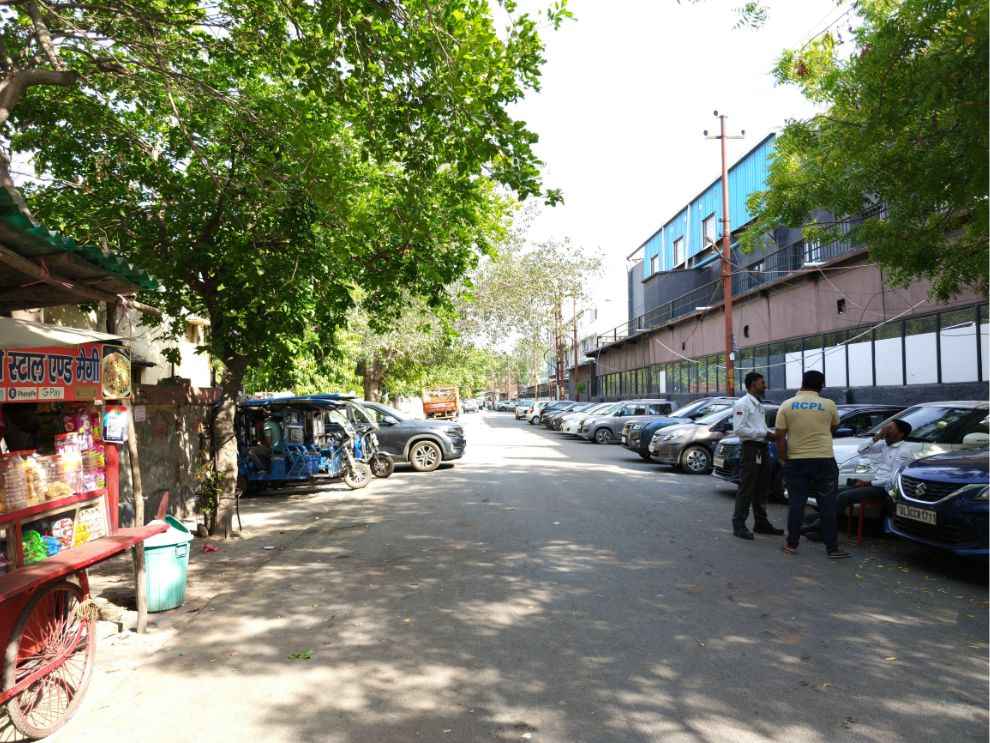
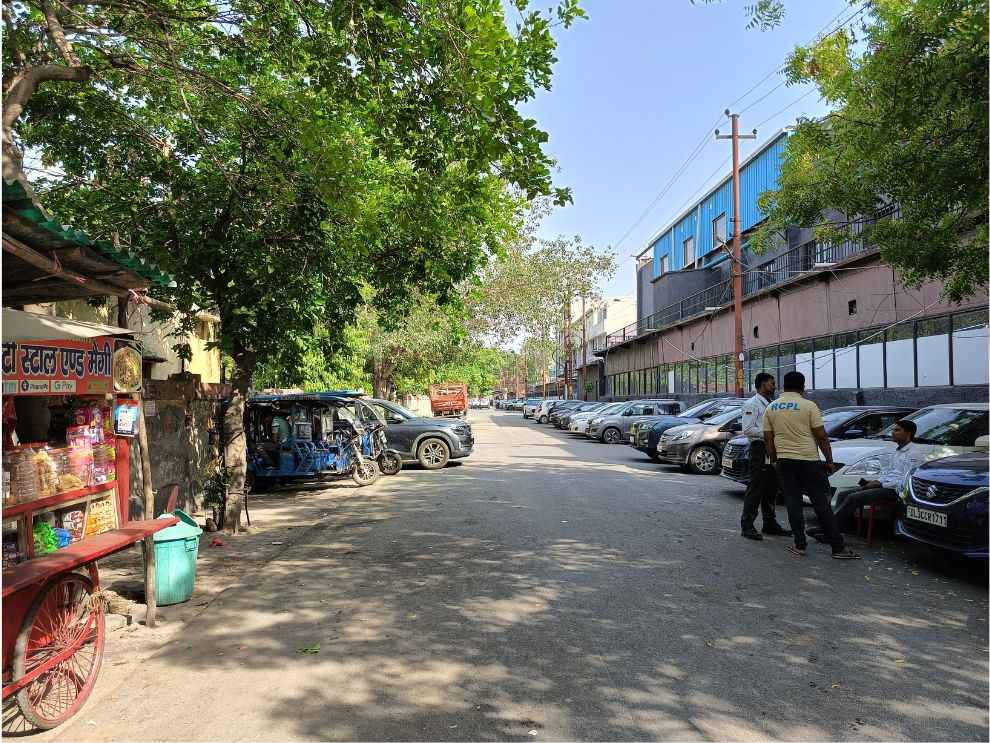 However, this is not the case all the time. I faced this challenge only once with the Realme 11 Pro+. That too, on a day when the sun was as bright as it can be. Even if this is a widespread issue, it can be easily fixed with a software update.
However, this is not the case all the time. I faced this challenge only once with the Realme 11 Pro+. That too, on a day when the sun was as bright as it can be. Even if this is a widespread issue, it can be easily fixed with a software update. 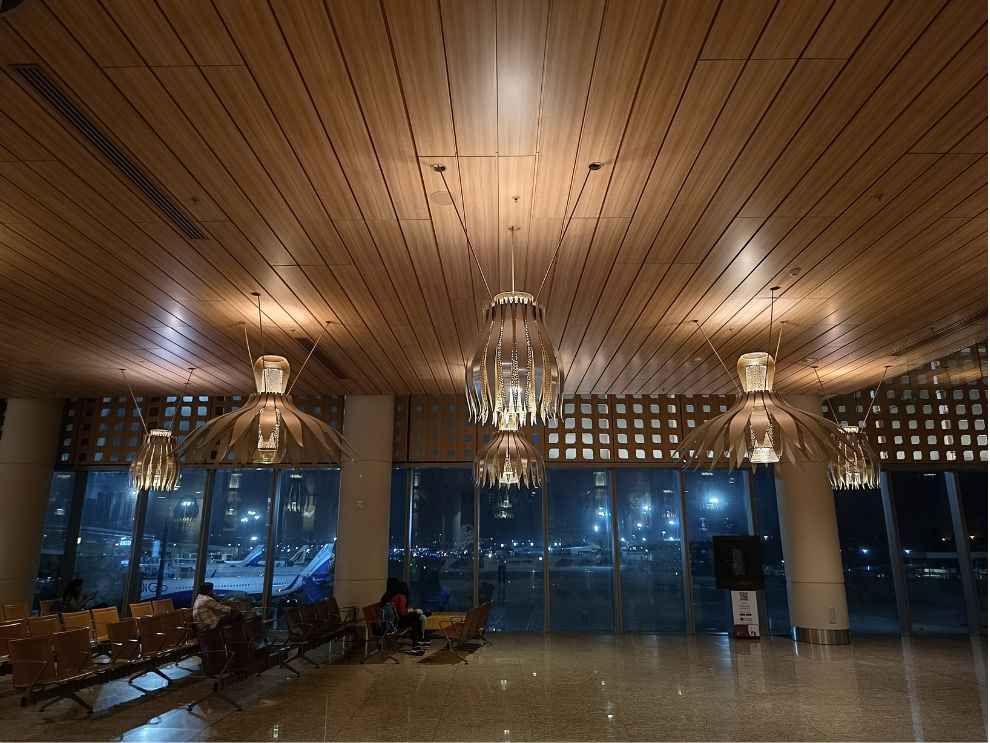 The Realme 11 Pro+ also comes with a lot of interesting features that we haven’t seen on other smartphones previously. For example, there is a dedicated Street Mode, which allows street photographers to select between four focal lengths in order to get the perfect shot. Further, we also get automatic zoom, which zooms into any part of the frame that you click on. Very cool. Given the “zoom to the next level” tagline, it is evident that the Realme 11 Pro+ comes with a focus on zoom and apart from the automatic zoom feature, Realme has also changed the game when it comes to digital zoom. The smartphone comes with up to 4X “lossless” zoom, which is the company’s term for its new zoom technique. Now, this basically crops the image from the primary shooter and given the 200-megapixels, the quality and details remain intact most of the time. Of course, this isn’t as good as proper optical zoom, but the images look way better than any other 4X digital zoom on any smartphone camera.
The Realme 11 Pro+ also comes with a lot of interesting features that we haven’t seen on other smartphones previously. For example, there is a dedicated Street Mode, which allows street photographers to select between four focal lengths in order to get the perfect shot. Further, we also get automatic zoom, which zooms into any part of the frame that you click on. Very cool. Given the “zoom to the next level” tagline, it is evident that the Realme 11 Pro+ comes with a focus on zoom and apart from the automatic zoom feature, Realme has also changed the game when it comes to digital zoom. The smartphone comes with up to 4X “lossless” zoom, which is the company’s term for its new zoom technique. Now, this basically crops the image from the primary shooter and given the 200-megapixels, the quality and details remain intact most of the time. Of course, this isn’t as good as proper optical zoom, but the images look way better than any other 4X digital zoom on any smartphone camera.  Other features include a single-take-like feature that takes 3 different variations of the same shot. There is also a Starry Mode, which is Realme’s name for the astrophotography mode on the Realme 11 Pro+.
Other features include a single-take-like feature that takes 3 different variations of the same shot. There is also a Starry Mode, which is Realme’s name for the astrophotography mode on the Realme 11 Pro+.  Apart from this, the images in wide angle are also good in general, but similar to other smartphones from the brand, the consistency isn’t really good and the difference between the primary and wide angle photos is very evident.
Apart from this, the images in wide angle are also good in general, but similar to other smartphones from the brand, the consistency isn’t really good and the difference between the primary and wide angle photos is very evident.  Coming to portraits, here also the Realme 11 Pro+ impressed me quite a bit. The edge detection is very good on the smartphone, and the portrait mode doesn’t hamper much with the subject’s skin tones and colours. Now, it still doesn’t compare with other heavy-duty flagship camera phones out there, but it is easily one of the best in this segment.
Coming to portraits, here also the Realme 11 Pro+ impressed me quite a bit. The edge detection is very good on the smartphone, and the portrait mode doesn’t hamper much with the subject’s skin tones and colours. Now, it still doesn’t compare with other heavy-duty flagship camera phones out there, but it is easily one of the best in this segment.  Realme 11 Pro+ Review: Performance Performance-wise, the Realme 11 Pro+ disappointed me a little bit. The smartphone uses a MediaTek Dimensity 7050 chipset paired with up to 12GB of RAM. While the RAM is more than enough for a smartphone, using a MediaTek Dimensity 7050 has put the Realme 11 Pro+ way behind competitors like the Poco F5 and iQOO Neo 7 in terms of performance. The benchmark numbers are not even close to the two more powerful devices in this range. In fact, in our tests, the Realme 11 Pro+ showed a lower AnTuTu score than its smaller sibling, the Realme 10 Pro.
Realme 11 Pro+ Review: Performance Performance-wise, the Realme 11 Pro+ disappointed me a little bit. The smartphone uses a MediaTek Dimensity 7050 chipset paired with up to 12GB of RAM. While the RAM is more than enough for a smartphone, using a MediaTek Dimensity 7050 has put the Realme 11 Pro+ way behind competitors like the Poco F5 and iQOO Neo 7 in terms of performance. The benchmark numbers are not even close to the two more powerful devices in this range. In fact, in our tests, the Realme 11 Pro+ showed a lower AnTuTu score than its smaller sibling, the Realme 10 Pro. 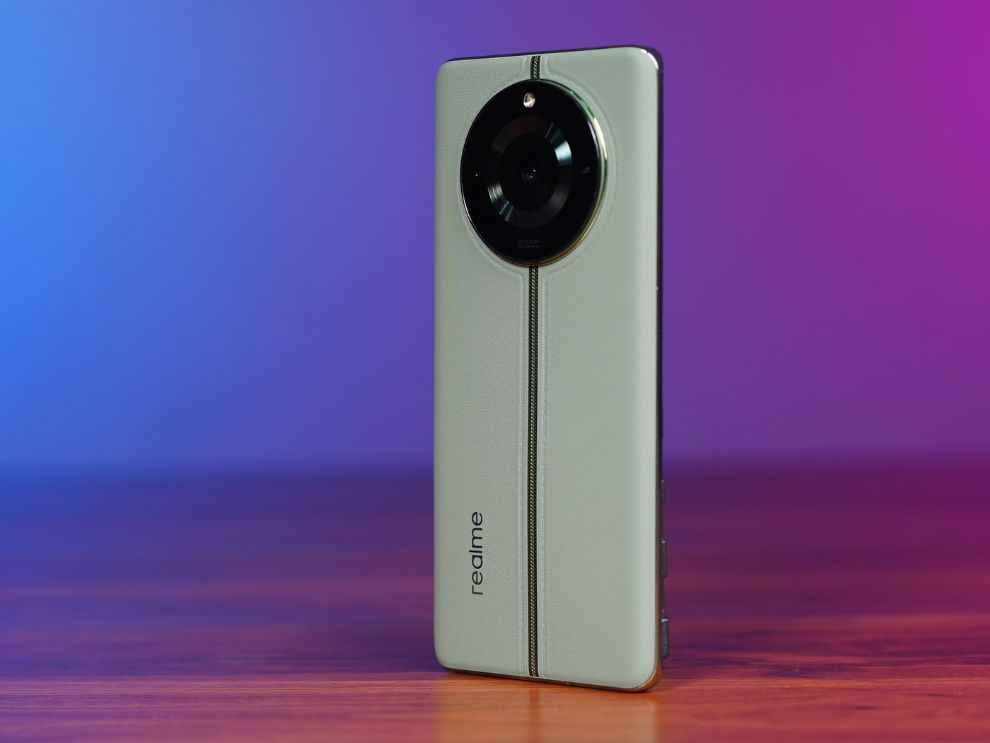 Now, you won’t feel the lack of power in day-to-day usage and yes, Realme’s focus this time around is not on performance, but on the camera, but given the 200-megapixel shooter and the slew of camera features that the company has given, the camera processing feels a bit slow, especially while using the camera in full 200-megapixel mode. Another issue with the smartphone is the software. While the UI and experience is very similar to the newer OnePlus and Oppo smartphones, the issue is bloatware. Similar to the Realme 10 Pro series, the Realme 11 Pro devices are also loaded with bloatware. Apart from your basic partner apps like some local social media apps and Realme’s own apps, there are three folders that are only there to give you the option of downloading some more partner apps. Yes, these apps aren’t installed on the smartphone, but you can’t even remove these folders. Furthermore, there are too many permissions and pop-ups to go through while setting up the smartphone initially which is a bit annoying. There are also these full-screen pop ups in Realme UI that ask you to “scan” or “open” an app. Upon start-up, I got at least 7 of these pop-ups. Not a good experience, especially when it is the first time a user has booted the device. During the Realme 11 Pro launch, the brand did tell us a way to avoid these pop-ups, but since most users won’t know how to do that, it is still a big negative in terms of the overall experience. Yes, it comes up every time you download a new app, unless you close it from the settings or during setup. Realme 11 Pro+ Review: Battery The battery on the Realme 11 Pro+ is good. The smartphone doesn’t drain a lot of battery, even during heavy-duty tasks like gaming or GPS navigation. We played an HDR video on YouTube at full resolution and brightness, and the smartphone only lost 4 percent battery. 1 hour of GPS navigation only drained 5 percent of the battery, which is very good.
Now, you won’t feel the lack of power in day-to-day usage and yes, Realme’s focus this time around is not on performance, but on the camera, but given the 200-megapixel shooter and the slew of camera features that the company has given, the camera processing feels a bit slow, especially while using the camera in full 200-megapixel mode. Another issue with the smartphone is the software. While the UI and experience is very similar to the newer OnePlus and Oppo smartphones, the issue is bloatware. Similar to the Realme 10 Pro series, the Realme 11 Pro devices are also loaded with bloatware. Apart from your basic partner apps like some local social media apps and Realme’s own apps, there are three folders that are only there to give you the option of downloading some more partner apps. Yes, these apps aren’t installed on the smartphone, but you can’t even remove these folders. Furthermore, there are too many permissions and pop-ups to go through while setting up the smartphone initially which is a bit annoying. There are also these full-screen pop ups in Realme UI that ask you to “scan” or “open” an app. Upon start-up, I got at least 7 of these pop-ups. Not a good experience, especially when it is the first time a user has booted the device. During the Realme 11 Pro launch, the brand did tell us a way to avoid these pop-ups, but since most users won’t know how to do that, it is still a big negative in terms of the overall experience. Yes, it comes up every time you download a new app, unless you close it from the settings or during setup. Realme 11 Pro+ Review: Battery The battery on the Realme 11 Pro+ is good. The smartphone doesn’t drain a lot of battery, even during heavy-duty tasks like gaming or GPS navigation. We played an HDR video on YouTube at full resolution and brightness, and the smartphone only lost 4 percent battery. 1 hour of GPS navigation only drained 5 percent of the battery, which is very good. 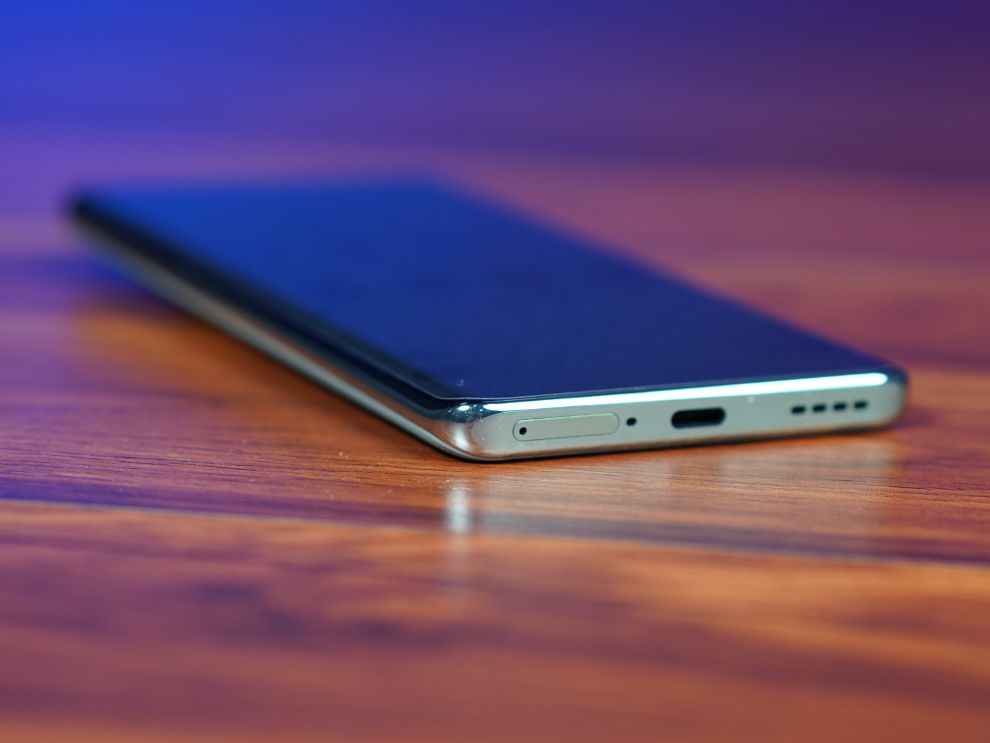 The battery is good, the charging speed is even better. The Realme 11 Pro+ comes with 100W fast charging and I put this to test. Here, the smartphone charged from 0 to 100 percent in just 27 minutes. This basically means you can put your phone on charge in the morning and by the time you make your tea or coffee, or even brush your teeth, you will have enough juice to last a full day. Good stuff. Realme 11 Pro+ Review: Verdict So the Realme 11 Pro+ has given Realme a much-needed redemption in the camera space. It uses one of the most advanced camera hardware in the whole market, which has paid off quite well, barring a couple of minor rough edges here and there. The smartphone’s display is the hidden gem and it turns out to be one of the best displays we have tested in this segment. Apart from all this, the smartphone’s design is stunning. As mentioned earlier, this is probably the best looking smartphone in this segment in my opinion.
The battery is good, the charging speed is even better. The Realme 11 Pro+ comes with 100W fast charging and I put this to test. Here, the smartphone charged from 0 to 100 percent in just 27 minutes. This basically means you can put your phone on charge in the morning and by the time you make your tea or coffee, or even brush your teeth, you will have enough juice to last a full day. Good stuff. Realme 11 Pro+ Review: Verdict So the Realme 11 Pro+ has given Realme a much-needed redemption in the camera space. It uses one of the most advanced camera hardware in the whole market, which has paid off quite well, barring a couple of minor rough edges here and there. The smartphone’s display is the hidden gem and it turns out to be one of the best displays we have tested in this segment. Apart from all this, the smartphone’s design is stunning. As mentioned earlier, this is probably the best looking smartphone in this segment in my opinion. 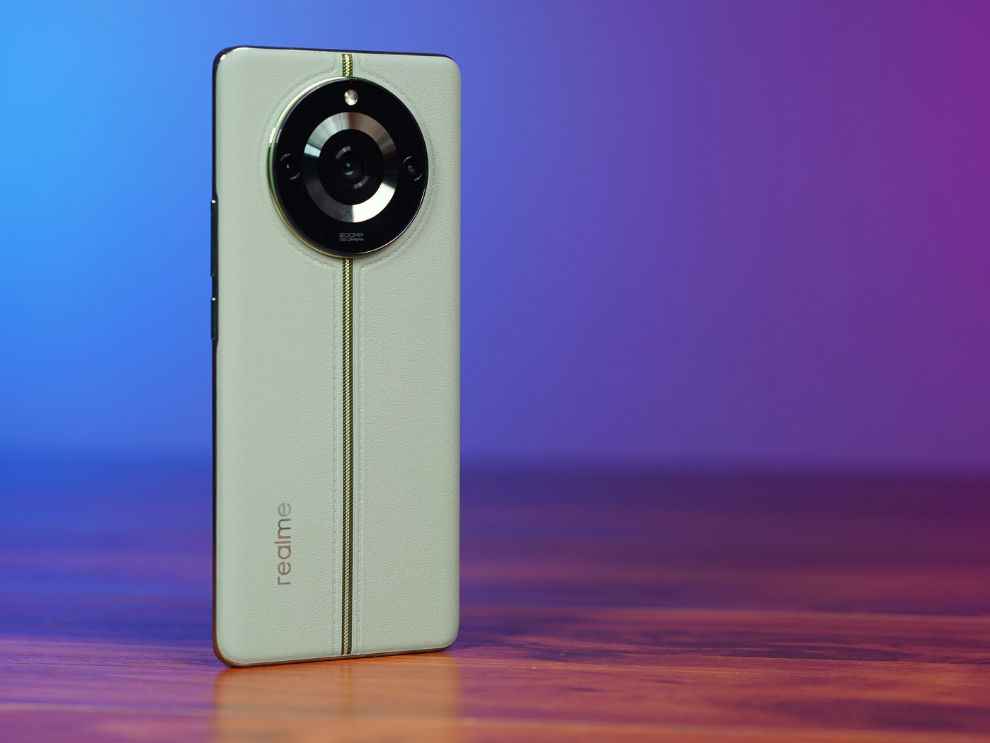 However, a good camera, design and display come at the cost of performance and user experience. The MediaTek Dimensity 7050 feels underpowered when put to test despite the 12GB RAM and the bloatware issue is so bad that people have been talking about it since even before the smartphone was launched. Overall, it is a decent upgrade, but it is high time Realme does something about the software, at least on a smartphone that costs around Rs 30,000 or more.
However, a good camera, design and display come at the cost of performance and user experience. The MediaTek Dimensity 7050 feels underpowered when put to test despite the 12GB RAM and the bloatware issue is so bad that people have been talking about it since even before the smartphone was launched. Overall, it is a decent upgrade, but it is high time Realme does something about the software, at least on a smartphone that costs around Rs 30,000 or more.